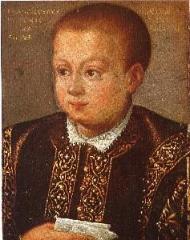¿Quién se casó con Catalina de Habsburgo, reina de Polonia?
Francisco III Gonzaga se casó con Catalina de Habsburgo, reina de Polonia el . Catherine of Austria tenía 16 años el día de la boda (16 años, 0 meses y 27 días). Francisco III Gonzaga tenía 16 años el día de la boda (16 años, 7 meses y 12 días). La diferencia de edad fue de 0 años, 6 meses y 15 días.
El matrimonio duró 0 años, 4 meses y 9 días (132 días). El matrimonio terminó el .
Sigismund II Augustus se casó con Catalina de Habsburgo, reina de Polonia . La diferencia de edad fue de 13 años, 1 meses y 14 días.
Catalina de Habsburgo, reina de Polonia

Catalina de Habsburgo (en polaco: Katarzyna Habsburżanka, en lituano: Kotryna Habsburgaitė; Viena, 15 de septiembre de 1533-Linz, 28 de febrero de 1572) fue archiduquesa de Austria por nacimiento, duquesa de Mantua por su matrimonio con Francisco III Gonzaga, y luego gran duquesa de Lituania y reina de Polonia al convertirse en la tercera esposa del rey Segismundo II Augusto Jagellón.
Leer más...
Francisco III Gonzaga

Francesco III. Gonzaga (* 10. März 1533 in Mantua; † 21. Februar 1550 ebenda) war von 1540 bis 1550 nominell Herzog von Mantua und Markgraf von Montferrat, gelangte jedoch nie zur selbständigen Regierung, da er bereits kurz vor seinem 17. Geburtstag starb.
Leer más...Catalina de Habsburgo, reina de Polonia


Sigismund II Augustus

Sigismund II Augustus (Polish: Zygmunt II August, Lithuanian: Žygimantas Augustas; 1 August 1520 – 7 July 1572) was King of Poland and Grand Duke of Lithuania, the son of Sigismund I the Old, whom Sigismund II succeeded in 1548. He was the first ruler of the Polish–Lithuanian Commonwealth and the last male monarch from the Jagiellonian dynasty.
Sigismund was elder of two sons of Italian-born Bona Sforza and Sigismund the Old, and the only one to survive infancy. From the beginning he was groomed and extensively educated as a successor. In 1529 he was chosen as king in vivente rege election while his father was still alive. Sigismund Augustus continued a tolerance policy towards minorities and maintained peaceful relations with neighbouring countries, with the exception of the Northern Seven Years' War which aimed to secure Baltic trade. Under his patronage, culture flourished in Poland; he was a collector of tapestries from the Low Countries and collected military memorabilia as well as swords, armours and jewellery. Sigismund Augustus' rule is widely considered as the apex of the Polish Golden Age; he established the first regular Polish navy and the first regular postal service in Poland, known today as Poczta Polska. In 1569, he oversaw the signing of the Union of Lublin between Poland and the Grand Duchy of Lithuania, which formed the Polish–Lithuanian Commonwealth and introduced an elective monarchy.
Sigismund Augustus married three times; his first wife, Elizabeth of Austria, died in 1545 at just eighteen. He was then involved in several relationships with mistresses, the most famous being Barbara Radziwiłł, who became Sigismund's second wife and Queen of Poland in spite of his mother's disapproval. The marriage was deemed scandalous and was fiercely opposed by the royal court and the nobility. Barbara died five months after her coronation, due to heavy illness. Sigismund finally wedded Catherine of Austria. Neither marriage resulted in living children.
Sigismund Augustus was the last male member of the Jagiellonian dynasty. Following the death of his sister Anna in 1596 the Jagiellonian dynasty came to an end.
Leer más...